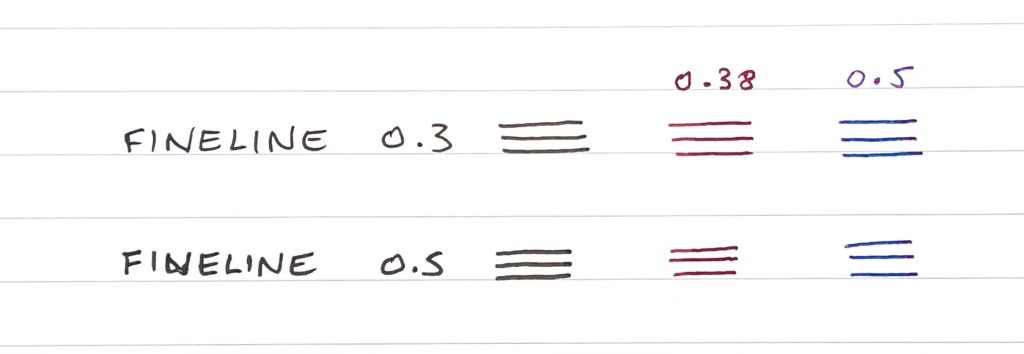
What is it?
I came across these pens while browsing on eBay and, at the princely sum of £2.33 each including delivery from China, I decided it was worth a look. If only just to experiment with it. So I bought both the F and the EF versions available.
So let’s start with the obvious: It’s an un-branded, Lamy Safari demonstrator look-alike. That is not too surprising, there are dozens of Chinese cheap copies of the Lamy Safari. As far as copies go, this is actually quite a nice one.

As with all Safari-style fountain pens, you get the cap with the metal paperclip on the outside and a sealing inner-cap on the inside, you get a barrel with a couple of ink-viewing cutouts (never understood the point of those in a clear demonstrator but hey, if Lamy has the holes so should the lookalike), you get a piston converter for your favourite inks, and you get a transparent section with a recessed grip and a finned ink feed. So far so good.
What you don’t get, however, is a traditional nib! the feed continues and ends up into a ballpoint. Or, technically, a rollerball (more on name-calling later in the post).

Does it work?
Yes it does! I started by loading the converter with Diamine Oxblood, one of my most well behaved inks, on the 0.38mm EF section. I was expecting that it will take a while for the feed to get saturated before it starts working but, to my surprise, it wrote instantly! And it wrote well, with a juicy wet flow. And it wrote instantly every time I picked it up. And I deliberately left it uncapped for 20 minutes to see what it will do and guess what? It still wrote instantly, just as a ballpoint does.

Time for a stronger challenge. I loaded up the 0.5mm F one with KWZ Sheen Machine. One of my worse behaving inks. It’s beautiful on the paper, but a nightmare on nibs. (Not to mention that I have never managed to load a pen without getting ink all over my fingers, what is it with that ink?). It worked absolutely fine. The sheen does not lend itself to F and EF, it really needs a M or B to show properly, but it’s there if you look for it. And of course it’s much drier flow than the Diamine. However, the pen wrote quickly and every time, without any issues of drying up. Success!


The only issue I do have, is that I don’t see much difference in thickness between the F and the EF. Compared to my fineliners (which is my usual test), they both are thinner lines than a standard EF, and not much to separate them from each other. Perhaps if they were both loaded with the same ink the difference may have been different.

As the ink is in the cartridge and can’t be eye-droppered, there is little point in being a clear demonstrator, as you can barely see what ink you have in the pen. To be fair though, I find that issue with most demonstrator pens that use a converter, and this pen is no different.
Interestingly, however, the shape of the 0.5 tip is shaped as a technical pen tip, rather than as a ballpoint, even though it still has a ball tip. Easier to use with a ruler, so even more brownie points for flexibility.

I have not yet tried to clean the pens, as I want to write a bit more with them, but I will update here once I know more. Interestingly, the converters do unscrew and come apart for cleaning, so that is definitely a bonus!
Is this a fountain pen?
There has been a big debate in the past, to determine what exactly IS a fountain pen, and which pens can actually be classed as fountain pens, and which not. Stylographs, for example, the pre-cursors to the modern day Rötring and Steadtler technical pens, are included in most fountain pen history books [such as Andreas Lambrou’s “Fountain Pens vintage and modern”], as well as fountain pen repair guides [such as Jim Marshall’s and Laurence Oldfield’s “Pen Repair”]. So have been fountain pens with glass nibs. They are a fundamental part of the evolution of the modern fountain pen. My preferred definition of a fountain pen is a writing device that uses a container of re-fillable liquid ink which it prevents from evaporating, with a writing point that allows the ink to be transferred, when in contact with paper.
Based on this definition, ballpoints and rollerballs are not fountain pens, because the ink container and the writing point are all-in-one refills, so I can’t clean them out and refill them with my favourite ink, whenever I want. By the same token, a Montblanc with a glass nib, or a Conway Stewart stylograph with a needle-point, are very much fountain pens.
This pen also fits the fountain pen definition. It does use a rolling ball rather than tines to transfer the ink to paper, but in every other way it allows me to use it as I would use any other fountain pen. And unlike having an open nib, it will not let the ink dry at the tip, so I can use it reliably with my most challenging inks. And it comes in a choice of tip widths (F-0.5mm and EF-0.3mm). So I’m happy to declare this thing a fountain pen and not feel guilty using it. I only wish it would come in a Medium or Broad so that I can take advantage of it with fancier inks.